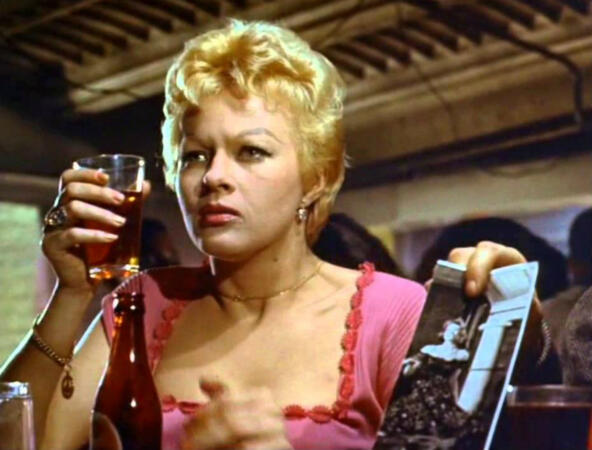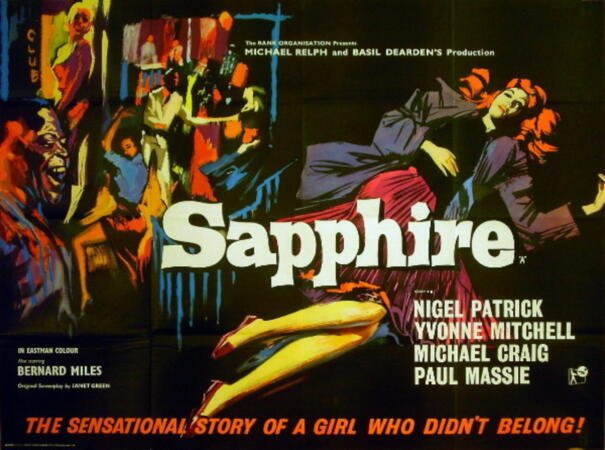
Starting in the late 1940’s, and continuing through to the end of the ‘50’s, Hollywood seemed to be obsessed with the concept of “passing” – light skinned black people passing for white. Though it wasn’t new, of course somehow it caught Tinseltown’s attention and a slew of films were made, almost all them dealing with women in particular who passed for white, and the tragedies and sorrow that they encountered.
Elia Kazan’s “Pinky,” “Lost Boundaries,” “Imitation Of Life,” “Band of Angels,” “The Night of the Quarter Moon,” “I Passed for White,” and the would-be “Gone with the Wind” rip-off, “Raintree County”, with Elizabeth Taylor and Montgomery Clift, which technically may not be a “passing” movie, though it deals with an antebellum Southern belle (Taylor), who goes slowly insane because she believes her real mother was a slave, who was her father’s lover (Turns out she wasn’t, but Taylor dies anyway for all her grief).
But for my money, the real doozy of the passing-for-white films wasn’t from Hollywood; instead it came from the U.K.
I’m referring to the 1959 British mystery film “Sapphire,” directed by Basil Dearden, who specialized, during the late 50′s and 60′s, in films with controversial subject matter, such as his 1961 film “Victim,” which dealt with a successful and closeted gay barrister who is being blackmailed and who fights back against his tormentors. It is credited for being the first movie in which the word “homosexual” was actually used in a film.
But “Sapphire” is in another realm altogether.
The premise centers on a police investigation of a young white woman found murdered in a park, but the 2 detectives assigned to the case – an older, seen-it-all, live and let live, tolerant one (Nigel Patrick), and his younger, wound-up, racist partner (Michael Craig) – begin to discover some rather strange things about the murder victim.
For example, in her closet and chest drawers, they find what they see as bizarre articles of clothing, such as tight sexy dresses and – God forbid – a RED petticoat! Then there’s her strange collection of jazz and American R&B music. Also, there’s the fact that none of her friends seem to know anything about her private life.
Well, as you’d guess, it turns out that the cops eventually find out that the murder victim was actually a light-skinned black woman passing for white (or, as they’re called in the film – a “lily skin”).
But of course that would explain the clothes and the red petticoat, which is *obviously* symbolic, suggesting a sexually promiscuous party girl. Because no self-respecting white woman would EVER be caught in clothes like that, or even listening to that kind of satanic, heathen music. Only a black woman with her loose moral standards would do those things.
As a result, the two cops must explore London’s dangerous and uncharted black community to find out more about their victim, and ferret out the identity of her killer (which, actually, to give the film credit, is a genuine surprise).

The amazing and amusing thing about this film is that, when it came out, it was heralded (and still is by some), as an honest and realistic portrait of black life and racism in the U.K., and it even won the BAFTA (UK’s version of the Oscars) for Best British Film in 1959.
Watching it today, one can’t help but laugh at its outrageous stereotypes and ridiculous situations. Unlike fine wine, there are some things that age very badly indeed.
There are too many to choose from, but my favorite scene is when the two cops, following a lead, visit a night club to find out more about their victim. They speak to the club owner who, in effect, tells them that all black people, no matter how light they are, can’t escape their real identity, because of that damn natural rhythm that’s in ALL of us – or the “beat of the bongo” as it’s called.
And to prove his point, the camera pans down to the feet of a “lily skin” (pictured above), and we see her feet twitching uncontrollably to the music, as if they have a mind of their own. You see, it’s “dat’ damn evil nat’rual rhythm” that exposes us every time, no matter how hard we try to hide. Curses!
Of course, the underlining message in the film is that Sapphire, in effect, brought her murder onto herself for living a lie, and not accepting who she really was, and living among her “own kind.”
And it goes without saying that, in all of these passing-for-white films, the lead was always played by a white woman for audience sympathy and identification, to heighten the tragedy. In other words, a white audience who watched Susan Kohner in “Imitation of Life,” or Yvonne De Carlo in “Band of Angels,” can say to themselves, “How sad for those poor wretched souls. There for the grace of God go I…”
The film used to be shown on local television stations years ago, and may be screened from time to time on the Turner Classics Movies cable network. But someone recently posted a not-so great looking but watchable version of it on YouTube in its entirety, which you can watch below. Though it could definitely look better than in a YouTube player, it is worth checking out because, if nothing else, it’s a truly fascinating look at attitudes and the mindset of a particular time, not that long ago.
